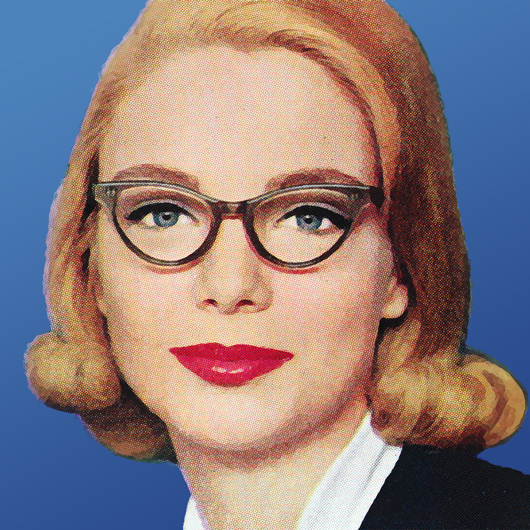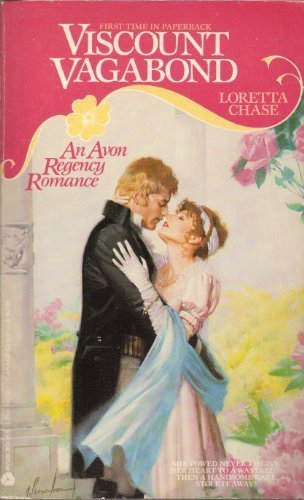I received an email from Emily, who wanted to draw my attention to a specific book she found in her library:
I don't know if you've seen this before, but I couldn't help sharing. I was at my library and I signed out Loretta Chase's Viscount Vagabond.
I wasn't sure what the cover would look like, because I knew old school ones were very over the top. I was picturing Fabio, fuchsia clinch, and what I got was so much stranger than that. SO MUCH Stranger!
Oh, lordy, Emily is not lying.
Here is the original cover to Viscount Vagabond, a Regency romance originally published in 1990:
It's pink! So very, very pink! But that's not the cover Emily got.
No, not that one either. That's the digital re-issue, and it's not horrible, but (I think I've talked about this) I'm not a fan of photograph covers on historicals. But that's not the cover Emily got, oh no.
Are you ready?
Prepare yourself.
Emily got the large print edition:
Emily: I suspect the cover has little to do with the story. Either that or it's biracial lesbian romance set in the Regency, in which case Loretta Chase is awesome.
Sarah: What the hell is that book about?
Carrie: It's a bleak, searing examination of race, gender, and class in Regency England. She commits suicide at the end. He is hung for a crime he didn't commit. It's very sad.
RedHeadedGirl: Did the large print edition time-travel everyone to to late 80s, early 90s? Cuz that's the only thing that explains that hair.
Sarah: Is she wearing a turtleneck?
Elyse: Okay, so apparently the Vagabond Viscount was African American. That's a plot twist. Wait, Carrie, did you seriously read it? Or is that depressing cover snark?
Carrie: I'm just snarking, because it looks like depressing things I had to read in college. But honestly the dark tale of oppression pretty much writes itself, doesn't it? I mean, that's an English Lit cover right there.
Elyse: I'm all REALLY?!?
Sarah: If I had that cover staring up at me from my bag, I'd be saying, REALLY?!? too!
And it's not just the Chase large print that has a very unique cover.
This is the large print for River Lady by Jude Deveraux:
And this is the large print for Twin of Ice by Jude Deveraux:
How amazing is that difference, huh? They look nothing like what one would expect on a romance novel.
Now, granted, these are much older titles and newer large print editions have the same if not very similar covers as the other editions. I noticed with some of the more recent books at Thorndike Press, for example, that the large print covers were different, but not completely different. For example, here's the A Rogue By Any Other Name large print cover:
And here's Jo Beverley's A Scandalous Countess, paperback on the left, and large print on the right:
The differences are far less, though clearly there's some other goals at work with the large print cover art – some of which, I imagine, address ease of reading and visibility to those with visual impairments.
Have you seen any interesting large print covers? What would you guess Viscount Vagabond was about based on the cover?










I just answered one of the HaBOs an hour or so ago, and LOL. Seeing the Jude Deveraux ones made me spit my drink on the keyboard. Twin of Ice looks like a Psychology Textbook cover.
Thanks! This just made my day.
I’m not sure what the book would be about, but it looks like the White female’s skin is puling back to reveal metal or lizard, so sci-fi with a Black female protagonist is my guess.
It’s a good thing I know what Twin of Ice is about…and what JD writes cuz that cover would never entice me to pick up. Eesh.
A lot of the books in the Black Lace line of fiction (“erotic fiction written for women by women”) went from stock photographs of the heroine to black-and-white covers, often using the “50 Shades” cover of a large object and often no characters. The covers (mostly new, some old) can be seen at the homepage: http://www.blacklace.co.uk/index.php
I’m a volunteer at the local library here, and part of that means shelving the large-print books. These covers are not exceptional – the entirety of the large print section is filled with dark, horrid, dreadful covers. There are a few exceptions to the rule, but most of them? They’re hideous and nothing like the covers for other editions of the same book. I’ve been baffled by this – why would publishers use bad Photoshopped flowers or something for the large print edition? Why not just use the same cover art as they did for the mass-market or hardcover or trade edition? Some of the more recent books seem to have taken this approach, but others are still coming out with horribly ugly or just horribly bland covers.
I don’t get it. At all. Can you get an interview with someone at a publishing house who can explain the different treatment large print covers often get, even now, than their mm, trade, or hc counterparts, Sarah?
Googled the large print cover of Twin of Fire. It’s just as funny (and creepy) as Twin of Ice. LOL
That’s not a book cover, that’s a still from an Obsession perfume ad.
I agree with Heather S—I don’t understand why publishers do this. Why not just use the same cover?
these are always amusing
SB Sarah said: “I’m not a fan of photograph covers on historicals.”
Me either. For some reason, they ‘read’ contemporary to me.
@SB Sarah and @Tamara Hogan:
SB Sarah said: “I’m not a fan of photograph covers on historicals.”
Me either. For some reason, they ‘read’ contemporary to me.
Photos on the covers of historicals always reek of anachronismitis, an affliction often shared by the writing inside. A well written, well-covered historical is a rare treasure.
Well, the last two, A Rogue by Any Other Name and A Scandalous Countess were definitely changed for readability, while trying to stay on trend with other romance covers (I’d assume they heard the complaints about the other book covers). They’ve made an effort to get the title onto a comparatively plain background – black print on her fair-skinned back, light print on a black fan – and to use a less curly font for the author’s names. Also, cutting out extraneous details.
I actually like them better – I hate having to squint to recognize a title or author name. And if it weren’t for the awful pictures, the others wouldn’t be so bad. I’m a big fan of the Twilight/50 Shades of Grey cover trend, though, when done with some thought to the book’s subject matter.
Unfortunately I don’t have time right now to hunt up a picture of it, but I happen to have the original hardcover of Viscount Vagabond, and that cover is what I’d call aggressively bland. For some reason late ‘80s Walker books all had really generic, bland covers, no matter what the genre. It was like they couldn’t afford actual professional cover artists.
I really like the original cover of the Chase book.
Do the publishers think that, heck, people reading the large print books are half blind anyway so it doesn’t matter what kind of crappy cover they slap on? Or is there some legitimate reason to make them high-contrast, low detail? And ugly?
There’s no excuse for ugly. However, as far as readability goes, what you want is a high-contrast, serif font with limited italics. Essentially, newsprint.
My text on fonts swears that black on ivory produces the bets result (least eyestrain, best legibility). Black on white or a pale color is next best. White on black or a very dark color is clearly legible, but produces eyestrain after a while, so should only be used for short texts (a title, for instance). Color on color starts to run into problems. Similarly, a serif font is supposedly easier to read than a sans-serif, and considerably easier than italics, or one of the calligraphic or other creative fonts. A less busy cover is also easier on the eyes.
So, as far as reducing eyestrain and increasing legibility, they’ve done pretty much the exact right thing. Of, course, the original cover of Viscount Vagabond up on top did basically the same things, and managed a perfectly attractive romance cover, so obviously there’s some room for improvement. Possibly they thought that the large print books were too hard to hide and felt their readers would prefer they disguise the content of the books?
That Vagabond Viscount cover is exactly like a cover on a vintage Octavia Butler literary sci-fi novel. It’s eerie.
Could it be that the ugly large print covers are less expensive to print and produce? Would it save on royalties to cover artists if they use crappy clip art? I assume the production numbers would be relatively small, so maybe ugly covers help reduce the overall cost?
@Heather S:
I’m working on it, but haven’t heard back. I have many questions. MANY. MANY questions, especially, as Aressi was talking about, they have specific visual/readability goals with font, contrast, etc. As a current (e-book) and future user of large print (oh, my poor eyeballs), I’m really hoppin’ curious.
@Qualisign & Tamara:
I’m so glad I’m not alone in my o_0?! reaction to photograph covers on historicals. It could be partly that I’ve been “taught” to expect painted images, or images that look like they were painted, so seeing a photograph confuses me a bit, but it’s definitely the fact that color photography didn’t exist in the time period being depicted.
For what it’s worth, the cover to my 1990s Silhouette Desire, Large Print, BEGUILED AGAIN was identical to the cover for the regular MMPB. Only, you know, larger. I guess Silhouette saw no reason to spring for new artwork.
If I were trying to do legible large-print covers cheaply, I’d probably pick a single item with an ivory background to put the author and title on, which I could then rotate against a generic cloth-looking background, for product recognition. Something like “Oh, it’s that gold-lace-edged fan that only opens out to 135 degrees on what looks like burgundy velvet: must be one of Jane Doe’s Twistleton series” with “and the midpoint of the fan’s curve is about sixty degrees up to the left: guess it’s the third book, then.” And pick, as Aressi said, Times or Nimbus or whatever free serif font your computer’s word processor/graphics layout program comes with that you can most easily read at a fontsize of not-actually-peering-closer-to-the-screen-to-read. (Or, if several of them match THAT criterion, which of them is the most attractive—but if and only if.)
(What is the equivalent of “Richard Roe” for women?)